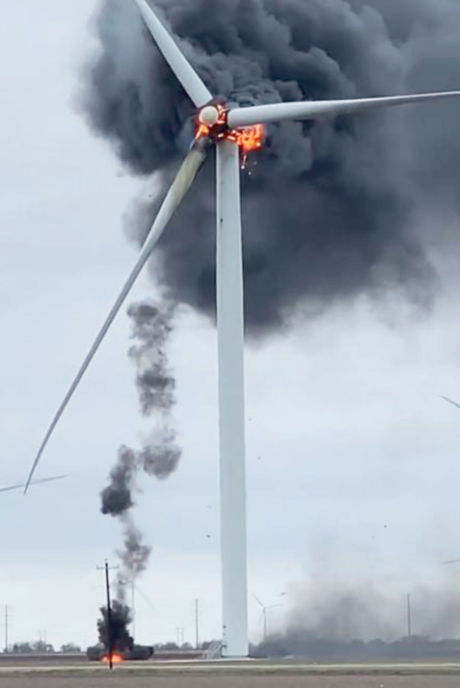After Decades of Subsidies, Now UK's Wind Power Companies Need Much Bigger Subsidies
by Rudy P. SysAdmin at howtofindthemoneyThe wind industry was founded on lies, built on myth and runs on subsidies. ‘Propaganda’ was conjured up by a Catholic Pope, employed with devastating effect by the Nazis and still maintains control over the masses in China. But it wasn’t until the wind industry switched into gear that propaganda really hit its straps. Being able to turn out lines such as “the wind is always blowing somewhere” and “the wind is free” was a mere doddle for the spin doctors and PR masters, who’ve worked overtime for nearly 20 years in an attempt to present wind power as part of an “inevitable transition” to an all wind and sun powered future.
As Dr John Constable details below, the wind industry has employed every euphemism, neutered every noun, assaulted every adjective and invalidated every verb in the English language. Or, as George Orwell put it, these propaganda masters have managed to: “give an appearance of solidity to pure wind”.

The Government’s Murky Wind Subsidies Revival Is A Costly Blunder
A complicated game of bait and switch is going on, and the consumer is getting a poor deal.
In the world of renewable energy nothing is what it seems. “Environmentally friendly” turns out to be devastating to the natural world. “Cheap” is expensive. “Local support” is found to be at a distance. “Sustainable” is, strange to say, short lived and unaffordable. A “contract” is non-binding. “Secure” is actually unreliable. Love is hate, black is white, and “Green” is a murky shade of brown.
So we should not be surprised when we are simultaneously told, as we were yesterday by government, that onshore wind is now so cost competitive it should be allowed to apply for subsidies again. It is quite usual for the wind industry, and their ministerial enablers, to be wreathed in smoke, surrounded by mirrors, and speaking in riddles.
But what is actually going on? Who is doing what to whom? A complicated game of bait and switch is what is going on, and the consumer is getting a poor deal. Here’s the background and how it works.
Since 2002 renewable electricity in the UK has received £38bn in subsidy from one scheme alone, the Renewables Obligation. The wind industry is the largest recipient, with onshore wind taking £10bn and offshore wind over £12 billion in subsidy since 2002. Big money.
The annual cost of all renewables subsidies now stands at £10bn a year, rising to £12 billion a year in the middle 2020s, when it will start to fall as existing subsidy entitlements expire.
The threat that this cumulative cost would spiral drove the Treasury in 2017 to argue for the closure of existing mechanisms to new entrants, and a moratorium on fresh schemes. They’d had enough.
But the industry hadn’t, and, in spite the rhetoric, the renewables sector is not keen to go subsidy free. Indeed, the physical thermodynamics of wind and sun mean, in my view, that it never will be competitive with fossil fuels or nuclear.
Wind and sunshine are very low-grade energy, close to random heat, and require vast and vastly expensive correction before the output is suitable to power a modern economy. This makes them intrinsically expensive.
That is why their capital costs haven’t fallen much, if at all, over time, and why it is so costly to balance an electricity grid in the presence of renewables, up from £367m a year in 2002, pre-renewables, to £1.5bn in 2019. Turning a sow’s ear into a silk purse is difficult.
But it’s the capital cost which is relevant to the economics of these schemes. Data from audited accounts shows that both onshore and offshore wind are still much more expensive than conventional generation. The capital cost of onshore wind has been stable since 2011 at about £1.5m a megawatt. A Combined Cycle Gas Turbine costs less than half that and is twice as productive. Offshore wind has seen some reduction, but still stands at about £3m a megawatt.
So renewables need subsidy, but government is currently unwilling. Fortunately for the industry, revenues from existing subsidies are so large that they can survive in the short term. The idea that their costs have fallen is the ‘bait’. Hence, the uneconomic bids for Contracts for Difference, and the implausibly low prices given for onshore wind in yesterday’s government announcement. In spite of their name, Contracts for Difference aren’t actually binding futures contracts, and the industry regards them as low cost “options”, giving them good PR and a favourable market position.
Now for the “switch”. When a greenwash thirsty government is heavily committed to a wind powered future, the industry will ask for new income support subsidies, or a carbon tax, or government pressure encouraging commercial consumers and government bodies into Power Purchase Agreements at high market rates for long periods.
That seems to be the wind industry’s plan, and a very good plan it is, for them. But why is this government playing along? The short-term Thunberg-appeasing gain is trivial compared to the threat. This is bad politics, as the public is generally not keen on onshore wind, and it’s bad economics, since high electricity costs rule out post-Brexit prosperity.
The 10 largest coal producers and exporters in Indonesia:
Source: Stop These Things
Sponsor Ads
Created on Mar 25th 2020 18:36. Viewed 3,012 times.
Comments
No comment, be the first to comment.



